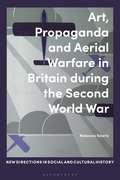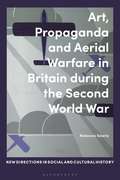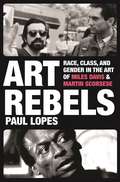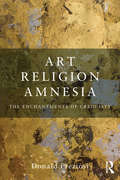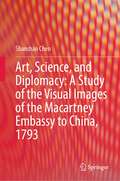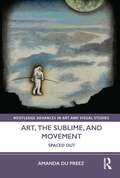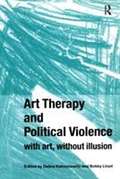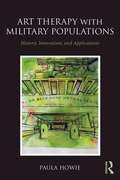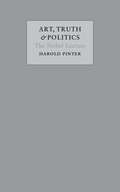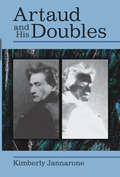- Table View
- List View
Art, Propaganda and Aerial Warfare in Britain during the Second World War (New Directions in Social and Cultural History)
by Rebecca SearleThe War Artists' Advisory Committee (WAAC) were responsible for the production of some of the most iconic images of the Second World War. Despite its rich historical value, this collection has been poorly utilised by historians and hasn't been subjected to the levels of analysis afforded to other forms of wartime culture. This innovative study addresses this gap by bringing official war art into dialogue with the social, economic and military histories of the Second World War. Rebecca Searle explores the tensions between the documentarist and propagandistic roles of the WAAC in their representation of aerial warfare in the battle for production, the Battle of Britain, the Blitz and the bombing of Germany. Her analyses demonstrate that whilst there was a strong correlation between war art and propaganda, the WAAC depicted many aspects of experience that were absent from wartime propaganda, such as class divisions within the services, gendered hierarchies within industries, civilian death and the true nature of the bombing of Germany. In addition, she shows that propagandistic constructions were not entirely separate from lived experience, but reflected experience and shaped the way that individuals made sense of the war. Accessibly written, highly illustrated and packed with valuable examples of the use of war art as historical source, this book will enhance our understanding of the social and cultural history of Britain during the Second World War.
Art, Propaganda and Aerial Warfare in Britain during the Second World War (New Directions in Social and Cultural History)
by Rebecca SearleThe War Artists' Advisory Committee (WAAC) were responsible for the production of some of the most iconic images of the Second World War. Despite its rich historical value, this collection has been poorly utilised by historians and hasn't been subjected to the levels of analysis afforded to other forms of wartime culture. This innovative study addresses this gap by bringing official war art into dialogue with the social, economic and military histories of the Second World War. Rebecca Searle explores the tensions between the documentarist and propagandistic roles of the WAAC in their representation of aerial warfare in the battle for production, the Battle of Britain, the Blitz and the bombing of Germany. Her analyses demonstrate that whilst there was a strong correlation between war art and propaganda, the WAAC depicted many aspects of experience that were absent from wartime propaganda, such as class divisions within the services, gendered hierarchies within industries, civilian death and the true nature of the bombing of Germany. In addition, she shows that propagandistic constructions were not entirely separate from lived experience, but reflected experience and shaped the way that individuals made sense of the war. Accessibly written, highly illustrated and packed with valuable examples of the use of war art as historical source, this book will enhance our understanding of the social and cultural history of Britain during the Second World War.
Art Rebels: Race, Class, and Gender in the Art of Miles Davis and Martin Scorsese
by Paul LopesHow creative freedom, race, class, and gender shaped the rebellion of two visionary artistsPostwar America experienced an unprecedented flourishing of avant-garde and independent art. Across the arts, artists rebelled against traditional conventions, embracing a commitment to creative autonomy and personal vision never before witnessed in the United States. Paul Lopes calls this the Heroic Age of American Art, and identifies two artists—Miles Davis and Martin Scorsese—as two of its leading icons.In this compelling book, Lopes tells the story of how a pair of talented and outspoken art rebels defied prevailing conventions to elevate American jazz and film to unimagined critical heights. During the Heroic Age of American Art—where creative independence and the unrelenting pressures of success were constantly at odds—Davis and Scorsese became influential figures with such modern classics as Kind of Blue and Raging Bull. Their careers also reflected the conflicting ideals of, and contentious debates concerning, avant-garde and independent art during this period. In examining their art and public stories, Lopes also shows how their rebellions as artists were intimately linked to their racial and ethnic identities and how both artists adopted hypermasculine ideologies that exposed the problematic intersection of gender with their racial and ethnic identities as iconic art rebels.Art Rebels is the essential account of a new breed of artists who left an indelible mark on American culture in the second half of the twentieth century. It is an unforgettable portrait of two iconic artists who exemplified the complex interplay of the quest for artistic autonomy and the expression of social identity during the Heroic Age of American Art.
Art Rebels: Race, Class, and Gender in the Art of Miles Davis and Martin Scorsese
by Paul LopesHow creative freedom, race, class, and gender shaped the rebellion of two visionary artistsPostwar America experienced an unprecedented flourishing of avant-garde and independent art. Across the arts, artists rebelled against traditional conventions, embracing a commitment to creative autonomy and personal vision never before witnessed in the United States. Paul Lopes calls this the Heroic Age of American Art, and identifies two artists—Miles Davis and Martin Scorsese—as two of its leading icons.In this compelling book, Lopes tells the story of how a pair of talented and outspoken art rebels defied prevailing conventions to elevate American jazz and film to unimagined critical heights. During the Heroic Age of American Art—where creative independence and the unrelenting pressures of success were constantly at odds—Davis and Scorsese became influential figures with such modern classics as Kind of Blue and Raging Bull. Their careers also reflected the conflicting ideals of, and contentious debates concerning, avant-garde and independent art during this period. In examining their art and public stories, Lopes also shows how their rebellions as artists were intimately linked to their racial and ethnic identities and how both artists adopted hypermasculine ideologies that exposed the problematic intersection of gender with their racial and ethnic identities as iconic art rebels.Art Rebels is the essential account of a new breed of artists who left an indelible mark on American culture in the second half of the twentieth century. It is an unforgettable portrait of two iconic artists who exemplified the complex interplay of the quest for artistic autonomy and the expression of social identity during the Heroic Age of American Art.
Art, Religion, Amnesia: The Enchantments of Credulity
by Donald PreziosiArt, Religion, Amnesia addresses the relationship between art and religion in contemporary culture, directly challenging contemporary notions of art and religion as distinct social phenomena and explaining how such Western terms represent alternative and even antithetical modes of world-making. In this new book, Professor Preziosi offers a critique of the main thrust of writing in recent years on the subjects of art, religion, and their interconnections, outlining in detail a perspective which redefines the basic terms in which recent debates and discussions have been articulated both in the scholarly and popular literature, and in artistic, political and religious practice. Art, Religion and Amnesia proposes an alternative to the two conventional traditions of writing on the subject which have been devoted on the one hand to the ‘spiritual’ dimensions of artistry, and on the other hand to the (equally spurious) ‘aesthetic’ aspects of religion. The book interrogates the fundamental assumptions fuelling many current controversies over representation, idolatry, blasphemy, and political culture. Drawing on debates from Plato’s proposal to banish representational art from his ideal city-state to the Danish cartoons of Mohamed, Preziosi argues that recent debates have echoed a number of very ancient controversies in political philosophy, theology, and art history over the problem of representation and its functions in individual and social life. This book is a unique re-evaluation of the essential indeterminacy of meaning-making, marking a radically new approach to understanding the inextricability of aesthetics and theology and will be of interest to students and researchers in art history, philosophy and religion and cultural theory.
Art, Religion, Amnesia: The Enchantments of Credulity
by Donald PreziosiArt, Religion, Amnesia addresses the relationship between art and religion in contemporary culture, directly challenging contemporary notions of art and religion as distinct social phenomena and explaining how such Western terms represent alternative and even antithetical modes of world-making. In this new book, Professor Preziosi offers a critique of the main thrust of writing in recent years on the subjects of art, religion, and their interconnections, outlining in detail a perspective which redefines the basic terms in which recent debates and discussions have been articulated both in the scholarly and popular literature, and in artistic, political and religious practice. Art, Religion and Amnesia proposes an alternative to the two conventional traditions of writing on the subject which have been devoted on the one hand to the ‘spiritual’ dimensions of artistry, and on the other hand to the (equally spurious) ‘aesthetic’ aspects of religion. The book interrogates the fundamental assumptions fuelling many current controversies over representation, idolatry, blasphemy, and political culture. Drawing on debates from Plato’s proposal to banish representational art from his ideal city-state to the Danish cartoons of Mohamed, Preziosi argues that recent debates have echoed a number of very ancient controversies in political philosophy, theology, and art history over the problem of representation and its functions in individual and social life. This book is a unique re-evaluation of the essential indeterminacy of meaning-making, marking a radically new approach to understanding the inextricability of aesthetics and theology and will be of interest to students and researchers in art history, philosophy and religion and cultural theory.
Art, Religion and Resistance in: Nostalgia for Paradise Lost (Modernity, Memory and Identity in South-East Europe)
by Maria Alina AsaveiThis book illuminates the interconnections between politics and religion through the lens of artistic production, exploring how art inspired by religion functioned as a form of resistance, directed against both Romanian national communism (1960-1989) and, latterly, consumerist society and its global market. It investigates the critical, tactical and subversive employments of religious motifs and themes in contemporary art pieces that confront the religious ‘affair’ in post-communist Romania. In doing so, it addresses a key gap in previous scholarship, which has paid little attention to the relationship between religious art and political resistance in communist Central and South-East Europe.
Art, Science, and Diplomacy: A Study of the Visual Images of the Macartney Embassy to China, 1793
by Shanshan ChenThis book examines how the Embassy members approached, selected, and represented information, and how, in doing so, they helped to shape European perceptions of China. The Macartney Embassy of 1793 was the first British diplomatic mission to China, seeking to open ties between the two empires. As part of the mission, the British government commissioned writers and artists to chronicle the geography and culture of a civilization that had, until then, been shrouded in mystery. A central focus of the book is the artwork itself, which provides a window into the diplomatic, artistic and scientific viewpoints underlying the mission. Drawing on archival research, the study recreates the processes through which the Embassy’s draughtsmen, scientists, and diplomats collaborated to represent the visual images, and how the materials were reworked for publication in London. The finished product demonstrates that the artists offered a distinct viewpoint in the representation of China, sometimes differing from the textual accounts, by blending scientific elements and artistic aesthetics in order to demystify China and make it more knowable to a British audience. It was in the interposition of text and image that the British public formulated an ambivalent perception of China that embraced both admiration and disdain. In addition to the scholars, the book targets general readers who are interested in global art and history, and East–West interactions. It contains important images with detailed visual and historical analysis that enable readers to acquire knowledge on how the British represented China and how that image helped to shape the European perception of China during the British global expansion in the eighteenth and nineteenth centuries, and beyond.
Art, the Sublime, and Movement: Spaced Out (Routledge Advances in Art and Visual Studies)
by Amanda du PreezThis book is a critical interdisciplinary approach to the study of contemporary visual culture and image studies, exploring ideas about space and place and ultimately contributing to the debates about being human in the digital age. The upward and downward pull seem in a constant contest for humanity’s attention. Both forces are powerful in the effects and affects they invoke. When tracing this iconological history, Amanda du Preez starts in the early nineteenth century, moving into the twentieth century and then spanning the whole century up to contemporary twenty-first century screen culture and space travels. Du Preez parses the intersecting pathways between Heaven and Earth, up and down, flying and falling through the concept of being “spaced out”. The idea of being “spaced out” is applied as a metaphor to trace the visual history of sublime encounters that displace Earth, gravity, locality, belonging, home, real life, and embodiment. The book will be of interest to scholars working in art history, visual culture, media and cultural studies, phenomenology, digital culture, mobility studies, and urban studies.
Art, the Sublime, and Movement: Spaced Out (Routledge Advances in Art and Visual Studies)
by Amanda du PreezThis book is a critical interdisciplinary approach to the study of contemporary visual culture and image studies, exploring ideas about space and place and ultimately contributing to the debates about being human in the digital age. The upward and downward pull seem in a constant contest for humanity’s attention. Both forces are powerful in the effects and affects they invoke. When tracing this iconological history, Amanda du Preez starts in the early nineteenth century, moving into the twentieth century and then spanning the whole century up to contemporary twenty-first century screen culture and space travels. Du Preez parses the intersecting pathways between Heaven and Earth, up and down, flying and falling through the concept of being “spaced out”. The idea of being “spaced out” is applied as a metaphor to trace the visual history of sublime encounters that displace Earth, gravity, locality, belonging, home, real life, and embodiment. The book will be of interest to scholars working in art history, visual culture, media and cultural studies, phenomenology, digital culture, mobility studies, and urban studies.
Art Therapy And Political Violence: With Art, Without Illusion (PDF)
by Bobby Lloyd Debra Kalmanowitz Shaun McNiff Diane WallerThe impact of political violence, war, civil war and acts of terrorism on the individuals involved can be extensive. Art therapy can provide an effective means of expressing the resulting experiences of fear, loss, separation, instability and disruption. Art Therapy and Political Violence brings together contributions from all over the world and from diverse theoretical backgrounds. With contributions from Northern Ireland, Kosovo, Israel and South Africa, the book includes numerous clinical examples to vividly illustrate the main issues affecting art therapy. The practical issues involved are also discussed, including subjects such as the importance of working with both the internal and external worlds of the individual and sensitivity to cultural issues. Art therapists, psychotherapists and other mental health professionals, particularly those working in the context of political violence or in countries of refuge, will find the experiences recounted in Art Therapy and Political Violence thought-provoking and will welcome the wealth of practical information provided.
Art Therapy And Political Violence: With Art, Without Illusion
by Bobby Lloyd Debra Kalmanowitz Shaun McNiff Diane WallerThe impact of political violence, war, civil war and acts of terrorism on the individuals involved can be extensive. Art therapy can provide an effective means of expressing the resulting experiences of fear, loss, separation, instability and disruption. Art Therapy and Political Violence brings together contributions from all over the world and from diverse theoretical backgrounds. With contributions from Northern Ireland, Kosovo, Israel and South Africa, the book includes numerous clinical examples to vividly illustrate the main issues affecting art therapy. The practical issues involved are also discussed, including subjects such as the importance of working with both the internal and external worlds of the individual and sensitivity to cultural issues. Art therapists, psychotherapists and other mental health professionals, particularly those working in the context of political violence or in countries of refuge, will find the experiences recounted in Art Therapy and Political Violence thought-provoking and will welcome the wealth of practical information provided.
Art Therapy With Military Populations: History, Innovation, And Applications
by Paula HowieFor decades, art therapy has proved to be a practical treatment for veterans and other military populations suffering from trauma. Art Therapy with Military Populations provides an in-depth overview of both the theoretical and historical bases of art therapy with these groups while also chronicling the latest trends in treatment and the continued expansion of treatment settings. Edited by an art therapist with over 25 years’ experience working with the military and including chapters by a variety of seasoned and innovative clinicians, this comprehensive new volume provides professionals with cutting edge knowledge and interventions for working with military service members and their families. Available for download are employment resources for art therapists who would like to work in military settings, a bonus chapter, historical documents on establishing art therapy, a treatment objectives manual, and resources for art therapists.
Art Therapy With Military Populations (PDF): History, Innovation, And Applications
by Paula HowieFor decades, art therapy has proved to be a practical treatment for veterans and other military populations suffering from trauma. Art Therapy with Military Populations provides an in-depth overview of both the theoretical and historical bases of art therapy with these groups while also chronicling the latest trends in treatment and the continued expansion of treatment settings. Edited by an art therapist with over 25 years’ experience working with the military and including chapters by a variety of seasoned and innovative clinicians, this comprehensive new volume provides professionals with cutting edge knowledge and interventions for working with military service members and their families. Available for download are employment resources for art therapists who would like to work in military settings, a bonus chapter, historical documents on establishing art therapy, a treatment objectives manual, and resources for art therapists.
Art, Trade, and Cultural Mediation in Asia, 1600–1950
by Raquel A. G. ReyesThis Palgrave Pivot explores the social and cultural impact of global trade at a micro-level from around 1600 to 1950. Bringing together the collaborative skills of cultural, social, economic, and art historians, it examines how the diffusion of trade, goods and objects affected people’s everyday lives. The authors tell several stories: of the role played by a host of intermediaries – such as apothecaries, artisans and missionaries who facilitated the process; of objects such as Japanese export lacquer-ware and paintings; of how diverse artistic influences came to be expressed in colonial church architecture in the Philippines; of revolutionary changes wrought on quotidian tastes and preferences, as shown in the interior decoration of private homes in the Dutch East Indies; and of transformations in the smoking and drinking habits of Southeast Asians. The chapters consider the conditions from which emerged new forms of artistic production and transfer, fresh cultural interpretations, and expanded markets for goods, objects and images.
Art, Truth and Politics: The Nobel Lecture
by Harold PinterArts, Truth and Politics is Harold Pinter's lecture on receipt of the 2005 Nobel Prize in Literature.
Art vs. TV: A Brief History of Contemporary Artists' Responses to Television
by Francesco SpampinatoWhile highlighting the prevailing role of television in Western societies, Art vs. TV maps and condenses a comprehensive history of the relationships of art and television. With a particular focus on the link between reality and representation, Francesco Spampinato analyzes video art works, installations, performances, interventions and television programs made by contemporary artists as forms of resistance to and appropriation and parody of mainstream television. The artists discussed belong to different generations: those that emerged in the 1960s in association with art movements such as Pop Art, Fluxus and Happening; and those appearing on the scene in the 1980s, whose work aimed at deconstructing media representation in line with postmodernist theories; to those arriving in the 2000s, an era in which, through reality shows and the Internet, anybody could potentially become a media personality; and finally those active in the 2010s, whose work reflects on how old media like television has definitively vaporized through the electronic highways of cyberspace.These works and phenomena elicit a tension between art and television, exposing an incongruence; an impossibility not only to converge but at the very least to open up a dialogical exchange.
Art vs. TV: A Brief History of Contemporary Artists' Responses to Television
by Francesco SpampinatoWhile highlighting the prevailing role of television in Western societies, Art vs. TV maps and condenses a comprehensive history of the relationships of art and television. With a particular focus on the link between reality and representation, Francesco Spampinato analyzes video art works, installations, performances, interventions and television programs made by contemporary artists as forms of resistance to and appropriation and parody of mainstream television. The artists discussed belong to different generations: those that emerged in the 1960s in association with art movements such as Pop Art, Fluxus and Happening; and those appearing on the scene in the 1980s, whose work aimed at deconstructing media representation in line with postmodernist theories; to those arriving in the 2000s, an era in which, through reality shows and the Internet, anybody could potentially become a media personality; and finally those active in the 2010s, whose work reflects on how old media like television has definitively vaporized through the electronic highways of cyberspace.These works and phenomena elicit a tension between art and television, exposing an incongruence; an impossibility not only to converge but at the very least to open up a dialogical exchange.
Art Without Borders: A Philosophical Exploration of Art and Humanity
by Ben-Ami ScharfsteinPeople all over the world make art and take pleasure in it, and they have done so for millennia. But acknowledging that art is a universal part of human experience leads us to some big questions: Why does it exist? Why do we enjoy it? And how do the world’s different art traditions relate to art and to each other? Art Without Borders is an extraordinary exploration of those questions, a profound and personal meditation on the human hunger for art and a dazzling synthesis of the whole range of inquiry into its significance. Esteemed thinker Ben-Ami Scharfstein’s encyclopedic erudition is here brought to bear on the full breadth of the world of art. He draws on neuroscience and psychology to understand the way we both perceive and conceive of art, including its resistance to verbal exposition. Through examples of work by Indian, Chinese, European, African, and Australianartists, Art Without Borders probes the distinction between accepting a tradition and defying it through innovation, which leads to a consideration of the notion of artistic genius. Continuing in this comparative vein, Scharfstein examines the mutual influence of European and non-European artists. Then, through a comprehensive evaluation of the world’s major art cultures, he shows how all of these individual traditions are gradually, but haltingly, conjoining into a single current of universal art. Finally, he concludes by looking at the ways empathy and intuition can allow members of one culture to appreciate the art of another. Lucid, learned, and incomparably rich in thought and detail, Art Without Borders is a monumental accomplishment, on par with the artistic achievements Scharfstein writes about so lovingly in its pages.
Art Without Borders: A Philosophical Exploration of Art and Humanity
by Ben-Ami ScharfsteinPeople all over the world make art and take pleasure in it, and they have done so for millennia. But acknowledging that art is a universal part of human experience leads us to some big questions: Why does it exist? Why do we enjoy it? And how do the world’s different art traditions relate to art and to each other? Art Without Borders is an extraordinary exploration of those questions, a profound and personal meditation on the human hunger for art and a dazzling synthesis of the whole range of inquiry into its significance. Esteemed thinker Ben-Ami Scharfstein’s encyclopedic erudition is here brought to bear on the full breadth of the world of art. He draws on neuroscience and psychology to understand the way we both perceive and conceive of art, including its resistance to verbal exposition. Through examples of work by Indian, Chinese, European, African, and Australianartists, Art Without Borders probes the distinction between accepting a tradition and defying it through innovation, which leads to a consideration of the notion of artistic genius. Continuing in this comparative vein, Scharfstein examines the mutual influence of European and non-European artists. Then, through a comprehensive evaluation of the world’s major art cultures, he shows how all of these individual traditions are gradually, but haltingly, conjoining into a single current of universal art. Finally, he concludes by looking at the ways empathy and intuition can allow members of one culture to appreciate the art of another. Lucid, learned, and incomparably rich in thought and detail, Art Without Borders is a monumental accomplishment, on par with the artistic achievements Scharfstein writes about so lovingly in its pages.
Artangel and Financing British Art: Adapting to Social and Economic Change (British Art: Histories and Interpretations since 1700)
by Charlotte GouldThe Artangel Trust has been credited with providing artists with all the money and logistics they need to create one-off dream projects. An independent art commissioning agency based in London, it has operated since 1985 and is responsible for producing some of the most striking ephemeral and site-specific artworks of the last decades, from Rachel Whiteread’s House to Jeremy Deller’s The Battle of Orgreave. Artangel’s existence spans three decades, which now form a coherent whole in terms of both art historical and political periodisation. It was launched as a reaction to the cuts in funding for the visual arts introduced by the Thatcher government in 1979 and has since adapted in a distinctive way to changing cultural policies. Its mixed economic model, the recourse to public, private and corporate funds, is the result of the more general hybridisation of funding encouraged by successive governments since the 1980s and offers a contemporary case study on broader questions concerning the specificities of British art patronage. This book aims to demonstrate that the singular way its directors have responded to the vagaries of public funding and harnessed new national attitudes to philanthropy has created a sustainable independent model, but also that it has been reflected more formally, in their approach to site. The locational art produced by the agency has indeed mirrored new distinctions between public and private spaces, it has reflected the social and economic changes the country has gone through and accompanied the new cultural geographies shaping London and the United Kingdom. Looking into whether their funding model might have had a formal incidence on the art they helped produce and on its relation to notions of publicness and privacy, the study of Artangel gives a fresh insight into new trends in British site-specific art.
Artangel and Financing British Art: Adapting to Social and Economic Change (British Art: Histories and Interpretations since 1700)
by Charlotte GouldThe Artangel Trust has been credited with providing artists with all the money and logistics they need to create one-off dream projects. An independent art commissioning agency based in London, it has operated since 1985 and is responsible for producing some of the most striking ephemeral and site-specific artworks of the last decades, from Rachel Whiteread’s House to Jeremy Deller’s The Battle of Orgreave. Artangel’s existence spans three decades, which now form a coherent whole in terms of both art historical and political periodisation. It was launched as a reaction to the cuts in funding for the visual arts introduced by the Thatcher government in 1979 and has since adapted in a distinctive way to changing cultural policies. Its mixed economic model, the recourse to public, private and corporate funds, is the result of the more general hybridisation of funding encouraged by successive governments since the 1980s and offers a contemporary case study on broader questions concerning the specificities of British art patronage. This book aims to demonstrate that the singular way its directors have responded to the vagaries of public funding and harnessed new national attitudes to philanthropy has created a sustainable independent model, but also that it has been reflected more formally, in their approach to site. The locational art produced by the agency has indeed mirrored new distinctions between public and private spaces, it has reflected the social and economic changes the country has gone through and accompanied the new cultural geographies shaping London and the United Kingdom. Looking into whether their funding model might have had a formal incidence on the art they helped produce and on its relation to notions of publicness and privacy, the study of Artangel gives a fresh insight into new trends in British site-specific art.
Artaud and His Doubles: Theory/text/performance: Artaud And His Doubles (Theater: Theory/Text/Performance)
by Kimberly JannaroneArtaud and His Doublesis a radical re-thinking of one of the most influential theater figures of the twentieth century. Placing Artaud's writing within the specific context of European political, theatrical, and intellectual history, the book reveals Artaud's affinities with a disturbing array of anti-intellectual and reactionary writers and artists whose ranks swelled catastrophically between the wars in Western Europe. Kimberly Jannarone shows that Artaud's work reveals two sets of doubles: one, a body of peculiarly persistent received interpretations from the American experimental theater and French post-structuralist readings of the 1960s; and, two, a darker set of doubles---those of Artaud's contemporaries who, in the tumultuous, alienated, and pessimistic atmosphere enveloping much of Europe after World War I, denounced the degradation of civilization, yearned for cosmic purification, and called for an ecstatic loss of the self. Artaud and His Doubles will generate provocative new discussions about Artaud and fundamentally challenge the way we look at his work and ideas.
Arte Ambientale, Urban Space, and Participatory Art (Routledge Advances in Art and Visual Studies)
by Martina TangaWorking in 1970s Italy, a group of artists—namely Ugo La Pietra, Maurizio Nannucci, Francesco Somaini, Mauro Staccioli, Franco Summa, and Franco Vaccari—sought new spaces to create and exhibit art. Looking beyond the gallery, they generated sculptural, conceptual, and participatory interventions, called Arte Ambientale (Environmental Art), situated in the city streets. Their experiments emerged at a time of cultural crisis, when fierce domestic terrorism aggravated an already fragile political situation. To confront the malaise, these artists embraced a position of artistic autonomy and social critique, democratically connecting the city's inhabitants through direct art practices.
Arte Ambientale, Urban Space, and Participatory Art (Routledge Advances in Art and Visual Studies)
by Martina TangaWorking in 1970s Italy, a group of artists—namely Ugo La Pietra, Maurizio Nannucci, Francesco Somaini, Mauro Staccioli, Franco Summa, and Franco Vaccari—sought new spaces to create and exhibit art. Looking beyond the gallery, they generated sculptural, conceptual, and participatory interventions, called Arte Ambientale (Environmental Art), situated in the city streets. Their experiments emerged at a time of cultural crisis, when fierce domestic terrorism aggravated an already fragile political situation. To confront the malaise, these artists embraced a position of artistic autonomy and social critique, democratically connecting the city's inhabitants through direct art practices.
